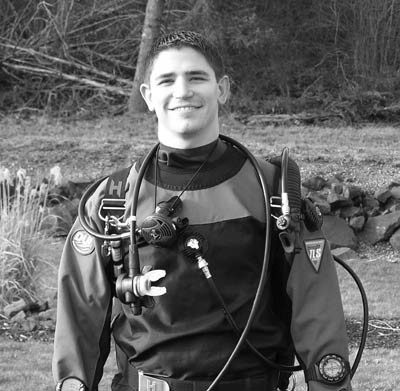While diving at one of his favorite sites in the San Juan Islands, Evergreen College student and recreational SCUBA diver Nick Brown became alarmed. It wasn’t that he was experiencing difficulty with his equipment or had lost contact with his dive buddy; Brown’s alarm was biological. “We were swimming along a beautiful wall counting fish when I saw what I thought looked exactly like Ciona savignyi,” a non-native, jellylike animal he had learned to identify as a participant in the REEF volunteer fish and invertebrate monitoring program.
“I was fairly certain it was the real thing, even though it had never been reported in the San Juan Islands,” said Brown, who took a picture and reported the sighting.
There are about 100 species of animals similar to Ciona savignyi that are native to Puget Sound. They are tunicates (called urochordates by scientists) and they normally filter water and feed on plankton. But invasive tunicates have the ability to completely cover over and smother native species. In November 2005 a small clump of Ciona savignyi was discovered at Sund Rock in Hood Canal; a year later there were thousands.
Divers with the REEF volunteer fish and invertebrate monitoring program gather information about marine fish and invertebrate populations and keep an eye out for non-natives like Ciona savignyi. Their data are collected using a standardized method and can be viewed by the public on the REEF website at www.reef.org.
By offering free fish and invertebrate identification classes, the SeaDoc Society has trained almost 300 REEF participants in Bellingham, Olympia, Port Townsend, Seattle and the San Juan Islands.
Last week REEF instructor Janna Nichols and SeaDoc Society Chief Scientist Joe Gaydos went out to confirm Brown’s sighting. “We didn’t find anything on the first dive,” reported Gaydos, “but on the second dive we saw the bad guys.” Nichols, who has participated in numerous tunicate removal projects in addition to teaching identification to volunteer divers, confirmed the identification. Gaydos and Nichols destroyed the four tunicates they found last week and are planning to re-survey the site this spring.
“I know these critters like a bad migraine,” said Nichols, “and I’m not happy about seeing them in the San Juans, but I couldn’t be happier that our volunteer SCUBA diver monitoring network is working.”
Pam Meacham, the aquatic invasive species coordinator at the Washington Department of Fish and Wildlife, agreed. “Early detection is our best hope for controlling the spread and eradicating it if possible.”
Divers who find invasive tunicates are asked to take a picture and report the sighting to Meacham at 360-902-2741
The SeaDoc Society (www.seadocsociety.org) ensures the health of marine wildlife and their ecosystems through science and education. A program of the Wildlife Health Center at the University of California, Davis (UC Davis), the SeaDoc Society has a regional focus on improving the health of the Salish Sea.



